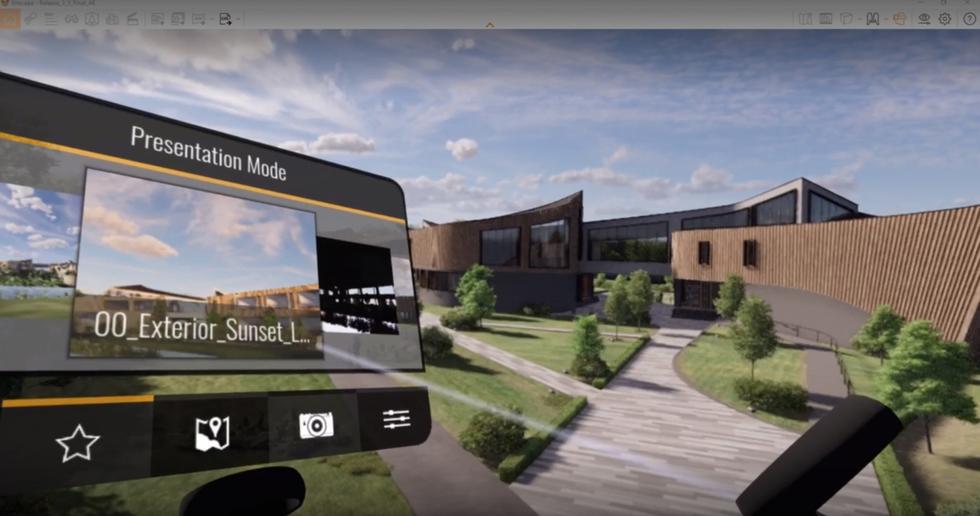Architectural virtual reality
The best virtual reality architecture solution for Revit, Sketchup, Rhino, Archicad, and Vectorworks


The best virtual reality architecture solution for Revit, Sketchup, Rhino, Archicad, and Vectorworks
Virtual reality (VR) is a hot topic in architecture and for good reason. Many Enscape users are experimenting with virtual reality in architecture design and are already using it in their daily business. A VR architectural presentation provides you with a full 360 view – enabling you to get a feeling for space and design and perceive the actual scale of a project. We started Enscape in 2013 with the vision that one day every architectural project can be experienced in virtual reality.
With virtual reality, you create an immersive 3D experience that touches clients emotionally and presents architectural ideas in the best way possible. Since everyone gets to engage and experience a model in a life-like simulation, it‘s easier to discuss details that may not be so easy to see and comprehend in another format. It’s simple to use as well – just one click, and the VR headset will start displaying your model in Enscape, allowing everyone to experience a building before it’s built.
As the cost of headsets such as Meta Quest 3 and HTC Vive Pro 2 have dropped significantly, virtual reality is now a feasible option for all modern architects and designers. Find out more about Enscape-supported headsets for VR architecture here, and all you need to know about virtual reality headsets on our Knowledge Base.


Start virtual reality architecture directly from your project in Revit, SketchUp, Rhino, Archicad, or Vectorworks without changing your workflow.
Architects and designers get a better feel of a project and enhance their productivity and iteration process. Navigating through your model is easy. Select view from favorites and take screenshots from within virtual reality. Presenting and reviewing projects has never been easier. Explore use cases of virtual reality in architecture here.
Modern and innovative architects always try to add more value for clients. Virtual reality is the key for more immersive and interactive experiences. How else can customers perceive their projects up close, feel changes in spatial planning immediately, and walk through projects themselves?
Even though virtual reality has been around for some years, it was video gaming that pushed it as a mainstream option. Notable firms such as KPF, Foster + Partners, ARUP, LHB, and Hassell have chosen virtual reality architecture with the Enscape plug-in to optimize their workflow and presentations.

Nine out of the 20 major architectural companies worldwide use VR in test cases or even in their daily business, and 83% of the top 100 architectural firms are using Enscape for virtual reality architecture rendering.
An architectural virtual reality experience amazes your clients. Being able to present the project in client meetings to emotionally impress customers is therefore the main use case of virtual reality. Virtual architecture gives your clients a better understanding of the design, and emotionally involves them in the project.
Showing the design to colleagues or supervisors in VR leads to faster and sounder discussions—even critics of the technology admit that. Architects who get the chance to experience their project in VR are believers from that day on.
Details like balustrades or stairs become much clearer if viewed in virtual reality and this offers the architect a way to experience his work in a more realistic way.
Enscape is the only one that is directly integrated into the CAD software. The integration enables a direct experience of the CAD model with only one click. Virtual reality application delivers the best results without additional effort, and it is the preferred solution for all use cases, where you need only a computer. You do not have to wait several weeks and do not have to spend a five-figure amount to create a walk-through. Additionally, the ease of use marks the integrated visualization, like Enscape, as the solution with the greatest potential for the future.
CAD models can also be exported into rendering engines that are known from the computer games industry. The advantage of this solution is the quality, which comes close to the quality of a photorealistic rendering. However, the process of creating such a virtual reality walk-through demands skill and effort as well as time. This results in much higher prices.
Some VR users are interested in sending high-quality images to their clients. To do this, the best option is to export the CAD model into a 360° panorama. Enscape allows you to generate 360° panoramas both in stereo and mono. They can be saved to a file or uploaded into the cloud where they are accessible via a web link. The panoramas can then be viewed using devices such as Google Cardboard and the Samsung Gear VR.
The Meta Quest 3 is a head-mounted display (HMD) that is currently supported by Enscape. Built for comfort and easy to use, you will enjoy faster load times, crisper details, and smoother play as you move with a sleek and streamlined optical profile.
The HTC Vive Pro 2 is a head-mounted display (HMD) that is currently supported by Enscape. Enjoy an elevated VR experience with cutting-edge graphics and immersive sound, as well as thoughtfully designed ergonomic features.